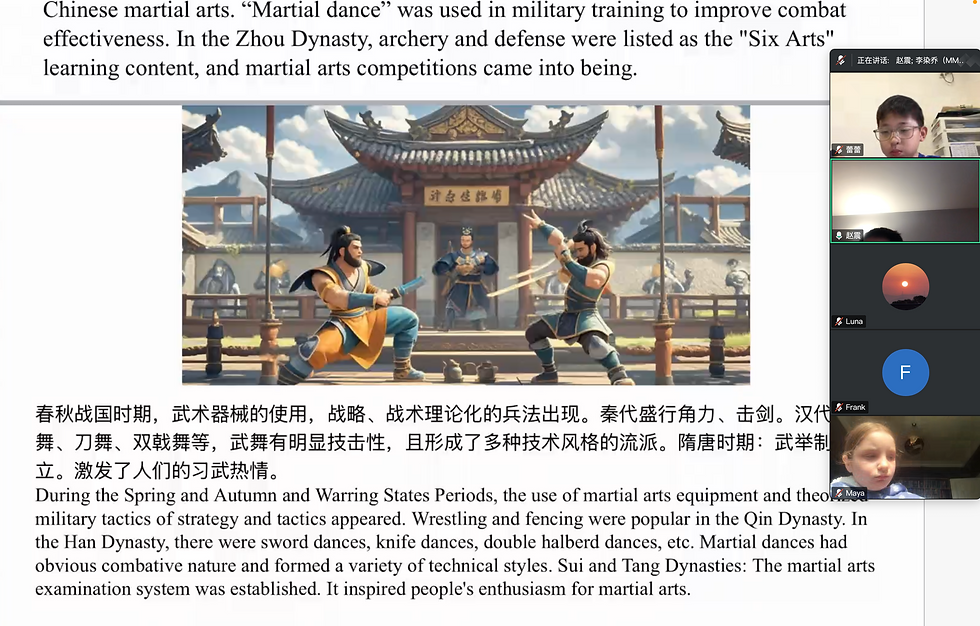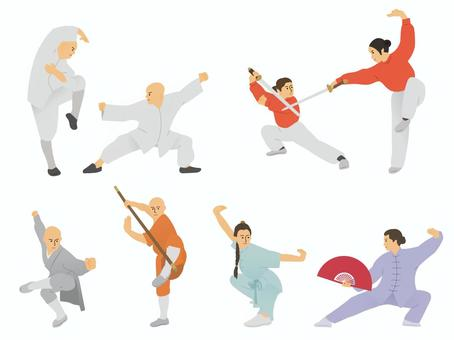【Shared Picture Book Reading】MM Chinese Club and Suzhou Experimental Primary School Bilingual Reading Class — Session Three
- Ranqiao Li
- Jun 11
- 3 min read
在2025年6月8日,英国苗苗中文学校(MM Chinese Club)与苏州实验小学(Suzhou Experimental Primary School)顺利举办了第四期双语绘本共读活动。这一次中英学生 们共同阅读的绘本为:《中国功夫(Chinese Kung Fu)》。
On 8 June 2025, MM Chinese Club in the UK and Suzhou Experimental Primary School successfully held the fourth session of their bilingual picture book reading programme. On this occasion, pupils from both China and the UK read the picture book Chinese Kung Fu together.


课堂伊始,孩子们通过中英文互相介绍自己,为接下来的跨文化交流热身。老师引导大家学习了与功夫相关的基础词汇,如“功夫”、“武术”、“刀”、“剑”等,不仅开拓了词汇量,也激发了兴趣。课堂的核心环节是双语绘本共读。每一位学生轮流朗读PPT中中英文内容,内容涵盖中国功夫的历史起源、主要流派、传统武器和文化内涵。从古代“武舞”到近代“李小龙”,从少林拳到太极拳,每一页都带着故事与画面。中国孩子们大胆朗读中文段落,英国孩子们勇敢尝试拼音和英文段落,彼此鼓励、相互支持。老师则及时帮助拼读、生词解释和文化补充,营造出轻松又富有深度的课堂氛围。
At the beginning of the lesson, the students introduced themselves in both Chinese and English, helping to warm up for the cross-cultural exchange ahead.
The teacher then guided everyone through a set of basic Kung Fu-related vocabulary, such as gōng fu (Kung Fu), wǔ shù (martial arts), dāo (knife), and jiàn (sword). This not only expanded their vocabulary but also sparked their interest in the topic.
The core part of the lesson was a bilingual picture book reading. Each student took turns reading the Chinese and English content from the PPT, which covered the history and origins of Chinese Kung Fu, its major styles, traditional weapons, and cultural significance.
From ancient “martial dances” to modern icons like Bruce Lee, from Shaolin Boxing to Tai Chi, every page came to life with vivid stories and illustrations.
The Chinese pupils confidently read aloud the Chinese passages, while the British pupils bravely tackled the pinyin and English parts. They encouraged and supported one another throughout. The teacher offered timely help with pronunciation, new vocabulary, and cultural explanations, creating a relaxed yet meaningful classroom atmosphere.


在阅读之后,老师提出了两个开放性问题:“你最喜欢哪种中国功夫?为什么?”“中国功夫的哪些特质最吸引你?”
孩子们认真思考,有的选择了“太极拳”因为它动作优美、令人平静;有的喜欢“少林拳”,因为它力量十足、动作帅气;还有人提到了功夫电影中的角色,比如李小龙、成龙,甚至电影《少林寺》。
而对于中国功夫的特质,有的学生说她喜欢它的速度与力量感,有的学生说他喜欢它象征着坚韧与和谐的文化内涵,还有的学生说他喜欢它多样化的流派……
每位学生用简短的英文或中文进行了分享,不少孩子在表达中展现了出色的语言组织能力与文化联想力,令人惊喜。
After the reading, the teacher posed two open-ended questions:“Which type of Chinese Kung Fu do you like the most, and why?”“What qualities of Chinese Kung Fu do you find most appealing?”
The children gave thoughtful responses. Some chose Tai Chi, saying they liked its graceful and calming movements. Others preferred Shaolin Boxing for its power and impressive moves. A few even mentioned characters from Kung Fu films, such as Bruce Lee, Jackie Chan, and even Shaolin Temple.
As for the qualities of Chinese Kung Fu, one pupil said she liked its speed and strength. Another said he admired its cultural meaning — a symbol of resilience and harmony. Others appreciated the great variety of styles within the world of Kung Fu.
Each student shared their ideas in either English or Chinese. Many of them impressed the teachers with their clear expression, creative thinking, and ability to connect language learning with cultural understanding.

这节课不仅是一堂语言学习课,更是一场文化之旅。孩子们在阅读中跨越语言边界,在交流中相互理解,在分享中建立信心。他们的好奇、认真与勇气,正是双语教育与文化沟通最动人的体现。
This lesson was more than a language activity — it was a meaningful cultural journey. Through reading, discussion, and joyful learning, children from China and the UK found a shared space where language, culture, and friendship blossom together.






Comments